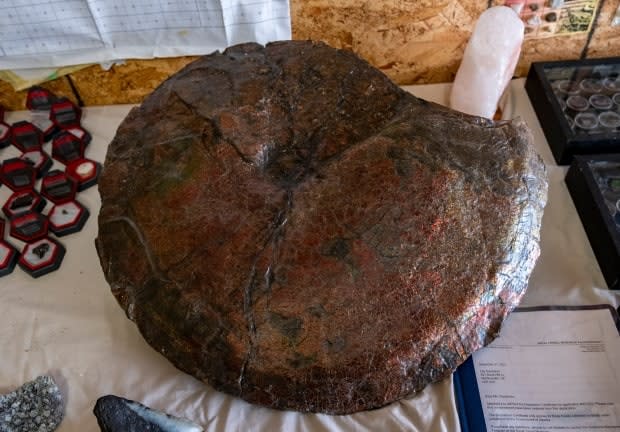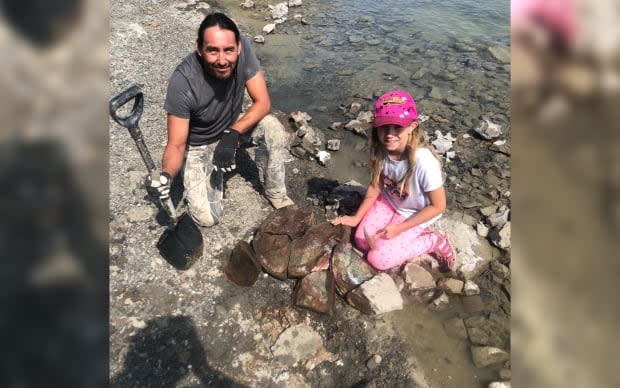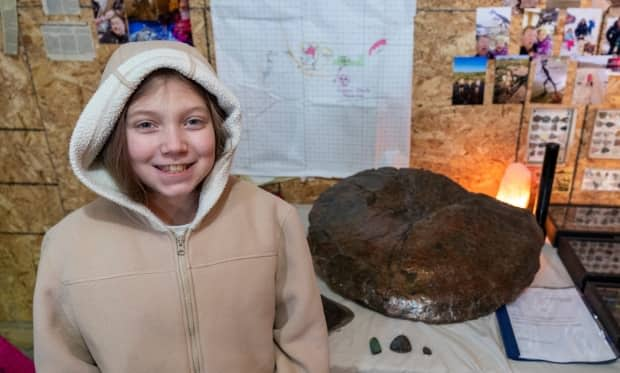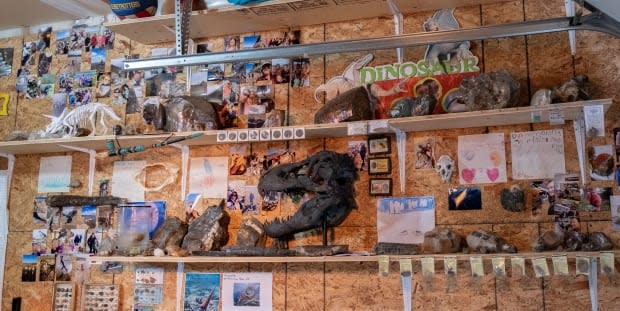Young fossil hunter shows off ammonite discovery in home museum

Lily Ganshorn stood proud as she brushed her hand across an ancient ammonite fossil on display in her family's garage in Martensville, Sask.
"I'm really happy because I really like it," the 10-year-old fossil hunter said. The ammonite is estimated to be millions of years old. Lily particularly likes this relic's colours that seem to sparkle, especially the bit that's yellow — her "fourth favourite colour."
"It's about a 70-million-year old ammonite from the Cretaceous Period," Lily's dad Jon Ganshorn said. "[It's] a jackpot in a sense of what we've been after — a goal that we've been working toward for the last four years."
Ammonites are extinct sea creatures that disappeared the same time as the dinosaurs. They are sometimes described as similar to squid or octopus but with external shells, said Dan Spivak, head of the resource management program at the Tyrrell Museum in Drumheller, Alta.
They're found in old sea beds, which is why they're abundant in southern Alberta if you know how and where to look.
Lily spotted the edge of this ammonite fossil in southern Alberta in August.
Ownership not guaranteed
There's no guarantee that fossil hunters can keep what they find.
Fossils are considered a Crown-owned resource and technically belong to the government. People who find ammonites can apply to the government, through the Tyrrell museum, for a transfer of ownership, Spivak said.
"We examine the photos of the fossil to determine if there's any scientific significance to the specimen itself and if there is, we ask that it be sent to the museum to be retained in the provincial collection," Spivak said.
Otherwise, the museum issues a certificate that transfers the ownership to the applicant.
Lily sent off a request to the museum. She received the official paperwork confirming that the ammonite is hers to keep right around Christmas.
"I feel really, really excited because I'm the real owner of it."
Dino gang adventures
Spivak said people search for fossils as a form of adventure, but the activity can also foster a profound link to the past.
"Fossils provide that tangible connection between us and time immemorial," Spivak said. "The sense of holding something in your hand that has gone extinct."
Lily and her dad are founding members of the "Dinosaur Hunter Gang." The goal is to help kids learn more about the Cretaceous Period, which began 145 million years ago and ended 66 million years ago, and paleontology, while fostering a curiosity about exploration.
It's really neat seeing specimens in a museum, but nothing beats the magic feeling of learning how to find them and properly dig them out for yourself, Jon Ganshorn said.
"It's modern day treasure hunting," he said, adding this ammonite discovery is a milestone for the duo, who only started searching for fossils a couple of years ago on a beach near their family cabin.

The Ganshorn's passion has only grown since then, leading them to explore areas of the South Saskatchewan River in southern Alberta.
Jon Ganshorn said they've been helped on their journey, befriending other fossil hunters in the area. He said they were taught by members of the Blood Tribe reserve, about 225 km southeast of Calgary, who shared their expertise on fossil hunting.
"We weren't expecting to find [the ammonite], but you always have high hopes," Jon Ganshorn said.
He said Lily noticed a hint of the specimen first, in a part of the riverbank that had been washed away by the rain. They weren't sure if it would be the real deal until they unearthed it.
"Your heart starts to pound … you end up breaking off the cap and it's like opening up a treasure chest," he said. They worked as a team to haul out the heavy specimen through rugged terrain. The transport was difficult but he said the group was motivated by his daughter's determination. He measured it at 26 inches (66 cm) across.

"Seeing her, the work that she put into it, it was by far one of [my] most proudest moments," he said.
The ammonite is one of the main attraction's at the mini-museum in the Ganshorn's garage, but the space is dedicated to a whole range of Dino Gang discoveries and donations. Minerals, stones and fossils fill the tables. Kids' drawings of ancient species and photos from adventures line the walls.

The pandemic temporarily sidelined their group adventures, but the duo hope they can pick it up again after winter. Lily said her favourite part of fossil hunting is making friends and memories. However, she also admits that there's also a lot of other "really cool" parts like learning about glowing minerals and smashing clumps of earth with a pickaxe in search of fossils.
Gather with care
The Ganshorns have put hours of research into learning how to hunt for fossils properly. Spivak said the Ganshorns are a "model example" of doing things by the book and asked people to keep certain rules in mind.
He said people should remember to seek permission from land owners (don't trespass), to make sure they're not searching in an area already designated to someone else and to get permission to take fossils out of province.



